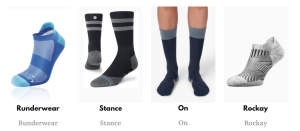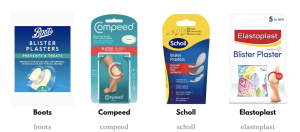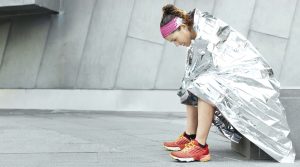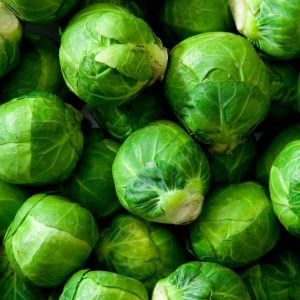For runners, blisters are like the final boss in a video game. During a marathon, you’ve battled ‘Misjudged Pacing’, ‘Gel-Based Nausea’ and ‘The Wall’ and slayed them all. You believe you’re through the worst of it, but you’re not, because suddenly ‘Blood Blister’ appears, on the tip of your second toe, enveloping your world in an agony that is beyond description.
The question we all want answered is: how do you avoid this happening? With blisters, prevention is better than cure. Once that blister has formed, there’s no going back to the smooth, pain free, pre-blister skin until weeks later. So in order to stop the blister forming in the first place we’ve asked a number of foot experts their tried-and-tested formulations for avoiding blisters while running.
And if you’re unfortunate enough to get one, we’ve also covered the best way to treat it mid-run so you can hobble to the finish line then post pictures of your domed blister to Strava for increased sympathy/disgust, and how to treat it post-run so you’re up and running again as soon as possible.
How do blisters form?
Firstly, let’s take a minute to look at the reasons why you get blisters. They’re caused by one of two things: either ill-fitting shoes or socks combined with excessive moisture between your skin and sock. ‘This results in friction, which causes the thin layers of the skin to separate and the body’s defensive response is to protect the skin from further damage by forming a sac filled with fluid,’ says Tony Gavin, podiatrist and CEO at Osgo Healthcare.
Mr Kumar Kunasingam of Schoen Clinic London says that blood blisters in particular can be one of the most painful types of blister. ‘They form from direct trauma where a blood vessel is injured due to repeated rubbing or hitting.’ So preventing them occuring in the first place is the best place to start.
How to prevent blisters
Check the fit of your shoes
This is crucial in terms of ensuring there are no hot spots or areas of rubbing, however small, when you’re running.
The first step is to ensure you have your feet properly measured. Many running shops have qualified staff to help you get the correct fit and the correct type of shoe. ‘The toe-box is important as that’s the area that houses your toes,’ says Gavin. ‘The length of the toe-box should be around a thumbnail in distance from your longest toe to the end of the shoe.’
Also, if you have wide feet, look for a shoe with a wider toe box. ‘It’s crucial that both the length and width of the toe box match the shape of your feet in order to provide adequate room and help prevent injury and discomfort,’ says Gavin.
However, it’s worth noting that if you’re planning to run a marathon or ultramarathon in them, you’ll need to allow a little more space, as your feet can sometimes swell the further you run.
Kunasingam says that you should also pay attention to your running style if you find you’re getting blisters in the same spots. ‘Your running style could mean you are landing on your toes, which may cause the impact to deviate onto the big toe in a flatter or more pronated foot. As there are big bones there they can rub on footwear and cause blister-like damage.’
Don’t neglect the laces
Kunasingam adds that it’s worth checking how stretchy the shoe’s laces are, as sometimes this can cause problems on the skin on the top of your foot. ‘Laces often stretch and don’t hold your foot properly, which can cause two problems: potential damage to the foot and wasting energy when you want to be optimising your energy while running, especially if you’re looking to build up to competition level.’
Lacing can also compensate for pressure points. A ‘heel lock’ – using the secondary top eyelets – sits the ankle more firmly to reduce rubbing on the Achilles area. Leaving the bottom eyelets unused, meanwhile, creates a more relaxed medial fit in a shoe that is blistering across a big toe.
Treat your feet like royalty
ANTI-FRICTION BALM CAN PLAY AN IMPORTANT ROLE IN REDUCING FRICTION BUILD-UP
‘If you’re about to go for a run, make sure you have clean skin and, if you do sweat a lot, it’s sensible to dry the skin,’ says Kunasingam. ‘This will mean you’re less likely to experience areas of friction as sweat can moisten the skin. You can use something like talcum power.’
Anti-friction balm can also play an important role in reducing friction build-up, so we’d recommend slathering some of the following all over your toes:
Squirrel’s Nut Butter
This is the gold standard of anti-chafe products – naturally made and does the job well time after time. Cover each toe in it and the sole of your feet pre-run and you lower the chances of friction building up.
RunGuard Natural Anti-Chafe Stick
Also made with all-natural ingredients, rub this stick all over your feet to reduce the chance of chafing.
Sock choice
So you have perfectly-fitted shoes and fully prepped feet, the next thing to check is your socks. Firstly, ensure they’re not made of cotton, as that can retain moisture instead of wicking it away to keep your feet dry. ‘It’s advisable to purchase dual-layer socks,’ says Gavin. ‘The inner layer moves with the foot, the outer with the shoe therefore eliminating friction at the skin surface.’ Merino is also worth looking out for, as it’s renowned for its sweat-wicking properties as well as high levels of breathability and insulation.

How to get rid of blisters
During a race
If you’ve taken the above measures to avoid blisters, fingers (and toes) crossed you should significantly reduce the little blighters’ occurrence. But anything can happen during a long race, so you should be prepared if the worst happens.
‘If you suffer regularly from blisters, taping your toes before running could be helpful,’ says Gavin. ‘A study in the Clinical Journal of Sports Medicine found that applying surgical tape to vulnerable areas before a run reduced blisters by 40 percent.’ Use something like Leukotape or a woven tape like K-Tape, and if things get really bad you can essentially ‘mummify’ your foot from heel to toe.
If you feel a blister developing, aim to act immediately. ‘Stop at a first aid post and get assistance,’ says Dr Lynn Thomas, St John Ambulance’s medical director. ‘You should not burst a blister as you increase the risk of it becoming infected. If it has burst spontaneously, then make sure all the fluid has drained. Try to wash the foot and then pat it dry with clean gauze. If you can’t wash it, try to keep it clean. Cover the blister with a plaster that has a pad bigger than the blister – special blister plasters are available and they have more padding.’
Whether to pierce blisters is a vexed subject. Conventional medical wisdom warns against the practice, pointing out that an intact blister ‘roof’ prevents infection, as Dr Thomas says. However, in reality, if a blister is full, and you have to keep using your feet, drainage is usually required. In Racing The Planet (RTP) endurance events, medics swab blisters with alcohol, then use a pin to pierce the ‘distal end’. ‘The furthest end away from the body,’ says Stanford University doctor Patrick Burns who works on the RTP series medical team. ‘So when you run it creates that constant pressure to squeeze out whatever juice is in it.’ They use gauze to absorb fluid and cover that with thin micropore tape, before applying adhesive spray.
Post-race treatment
If you cross the finish line and peel off your socks to discover your feet are covered in blisters, your best bet is to continue to treat them by keeping the area clean, dry and covered with a breathable waterproof plaster, dressing or a blister-specific plaster, which often has more padding.
‘It’s possible at this stage that the blister can become infected,’ says Gavin. ‘Signs of infection include redness around the edge of the blister and if the fluid inside the blister is red or pus-like. If you think your blister may be infected, seek medical advice, particularly if you have other health conditions such as diabetes.’
‘Sometimes there is a need to burst the blister but you should seek medical assistance,’ adds Dr Thomas. ‘A pharmacist may be able to assist.’
Blister plaster recommendations:

Source Article: https://www.runnersworld.com/uk/health/a35530604/how-to-get-rid-of-blisters/?utm_campaign=buffer&utm_content=buffer83062&utm_medium=social&utm_source=facebook.com




